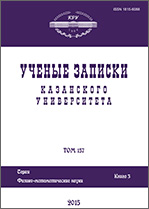|
|
Uchenye Zapiski Kazanskogo Universiteta. Seriya Fiziko-Matematicheskie Nauki, 2015, Volume 157, Book 2, Pages 5–19
(Mi uzku1302)
|
|
|
 |
This article is cited in 1 scientific paper (total in 1 paper)
Shock waves in liquid under the pulsed action of a cavitation bubble on a rigid wall
A. A. Aganin, T. S. Guseva, L. A. Kosolapova, V. G. Malakhov
Research Institute of Mechanics and Machinery of Kazan Scientific Center of the Russian Academy of Sciences, Kazan, Russia
Abstract:
Shock waves arising in water during the collapse of a cavitation bubble near a plane rigid wall are studied in the case with a liquid layer (interlayer) between the bubble and the wall. The shock waves determine to a large extent the pulsed action of the bubble on the wall, which is known as one of the main cavitation erosion mechanisms of body surfaces. The collapse of an initially slightly oblate spheroidal bubble is considered when a thin high-speed jet directed to the wall is formed. The main attention is drawn to the initial stage of the jet impact when the wall is subjected to the pressure comparable to the water hammer pressure. A two-step numerical technique, in which the stage of jet formation is evaluated by the boundary element method, is used. The stage of pulsed action produced by the jet is calculated by direct numerical simulation based on the equations of gas dynamics. The study is performed for interlayers, the thickness of which is 100 and more times less than the initial radius of the bubble. It has been found that if the interlayer thickness is by a factor of $3\cdot10^{-4}$ and more less than the initial radius of the bubble, the maximum pressure on the wall remains higher than the water hammer pressure, as is in the case without the interlayer. For thicker interlayers, the load on the wall does not exceed, in general, the water hammer pressure.
Keywords:
cavitation erosion, bubble collapse near wall, cumulative jet, shock impact.
Received: 04.03.2015
Citation:
A. A. Aganin, T. S. Guseva, L. A. Kosolapova, V. G. Malakhov, “Shock waves in liquid under the pulsed action of a cavitation bubble on a rigid wall”, Uchenye Zapiski Kazanskogo Universiteta. Seriya Fiziko-Matematicheskie Nauki, 157, no. 2, Kazan University, Kazan, 2015, 5–19
Linking options:
https://www.mathnet.ru/eng/uzku1302 https://www.mathnet.ru/eng/uzku/v157/i2/p5
|

| Statistics & downloads: |
| Abstract page: | 406 | | Full-text PDF : | 249 | | References: | 46 |
|




 Contact us:
Contact us: Terms of Use
Terms of Use
 Registration to the website
Registration to the website Logotypes
Logotypes







 Citation in format
Citation in format 
